Menu

Did you know livestock production makes up about 40% of the world agricultural GDP? This shows how important it is for the economy. In 2020, we produced 335.4 million tonnes of meat, bringing in USD 1,329.1 million. With the world’s population set to hit 9.5 billion by 2050, meeting the demand for meat sustainably is a major challenge.
Sustainable farming isn’t just a passing trend. It’s a must to balance the need for protein with protecting our planet. Livestock alone generates 7.1 gigatons of CO2 every year. We must move to farming that’s kinder to the environment. This means making food safer, keeping animals happier, and using tech to cut down on pollution.
I love being a part of sustainable livestock farming. It’s key to combine methods that are good for the earth and work well. The world’s farms depend a lot on livestock, which gives us 40% of our food. Livestock also provides jobs and income for 500 million people. But all this also means we must protect the environment, ensure food is safe, and treat animals well.
Livestock farming must tackle its high levels of greenhouse gases, which are bad for the planet. For example, in Kazakhstan, there’s a push to increase beef but also lower emissions. Ethiopia and Bangladesh are also working hard. They want their farming to help fight climate change, focusing on ethical farming practices.
The need for sustainable farming is global. For example, in Mexico, new technology cut down 3,388,670 tons of CO2 in 2016. A project in Vietnam helped over 151,000 farmers learn better animal care. In Colombia, 32,000 hectares were turned into eco-friendly farms, saving 1.05 million tons of CO2 since 2011.
The idea behind sustainable livestock farming is complex. It deals with money, the planet, being good to animals, and society. Planning well helps with things like how much land you need, building fences, and getting the money you need. We must carefully think about soil and waste to succeed.
I look into different animals like cows, sheep, or chickens for my farm. Knowing what people want, like ‘organic’ or ‘free-range,’ is very important. And we must always follow rules to make sure our farm is good for the environment and the animals.
It’s important to balance making money with doing what’s right. By using the best ways and new ideas, we hope to make our farming future great.
Livestock farming’s impact on the environment is a top concern. It is a major source of greenhouse gas emissions and harms soil health. This demands a shift towards more eco-friendly methods.
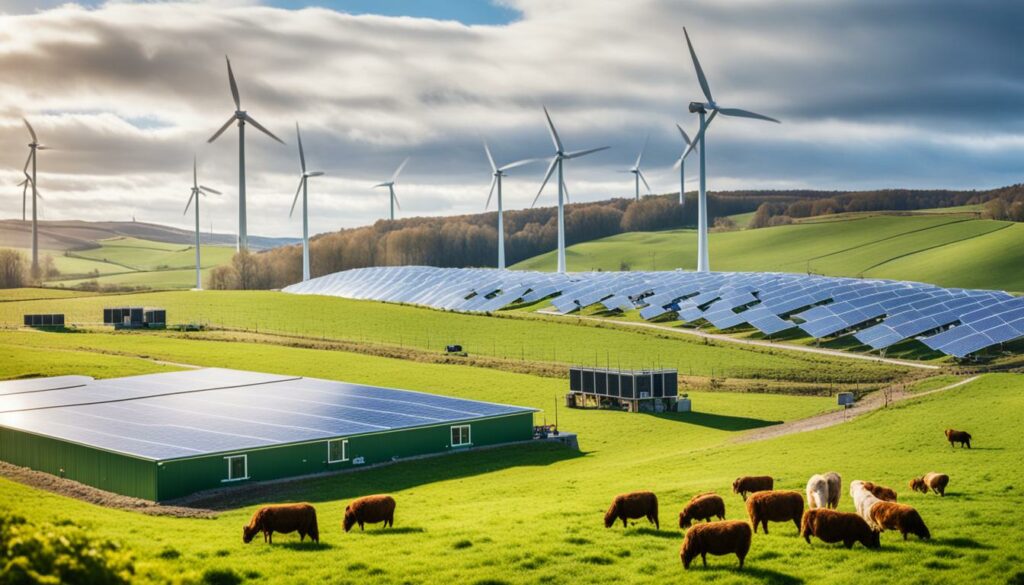
Animal farming is accountable for 65% of the world’s nitrous oxide emissions. This gas is 296 times more potent than carbon dioxide. It creates about 15% of the world’s greenhouse gases, more than all transport put together. Annually, it releases about 7516 million tons of carbon dioxide, highlighting the need for carbon-neutral farming.
This industry emits more greenhouse gases than power generation. In fact, it’s ahead of the transport industry in emissions. Research suggests that halting meat and dairy production could hold off greenhouse gas emission growth for 30 years. These points underline the severe environmental impact of livestock and the call for greener methods.
Livestock farming also harms soil health. It uses up nearly 70% of farming land and contributes to issues like deforestation and water pollution. Sustainable farming methods are crucial to mitigate these damages.
Actions like reducing erosion and adding to organic matter are key. They help improve soil health and its ability to withstand extreme weather. Biodiversity is also essential for soil health, leading to increased productivity and resilience.
Choosing carbon-neutral farming benefits the environment in two significant ways. It helps in reducing both greenhouse gas emissions and improving soil health. This is vital for the future health of our planet.
Innovations in digitalisation and smart technology are key for sustainable livestock farming. They make farming more efficient, sustainable, and ethical. I’ll explain how these new ideas are changing livestock farming.
Digitalisation has really changed how we look after animals. IoT sensors and AI help farmers know the health and behaviour of their animals. This data helps make better decisions.
Automation means less hard work for farmers, which saves money and time. Automated feeding makes sure animals get the right food, keeping them healthy and productive. This tech also helps manage diseases, which lowers greenhouse gas emissions.
In Uruguay, smart livestock farming has made farms better for the environment and more energy-efficient. And in Vietnam, thousands of farmers are using digital tools thanks to support from banks.
Now, livestock farming uses smart devices that give important information. These technologies help use resources better, reduce environmental impact, and care for animals. In Colombia, a project has turned a lot of land into a system that keeps 1.05 million tons of CO2 out of the air.
There are new feed and supplement solutions that help cut down on methane. Some studies have found they can reduce methane a lot, up to 33%.
Livestock farming around the world is getting smarter. This helps us feed the growing population without harming the planet. It also supports agriculture that makes the land healthier, which helps millions.
| Statistics | Details |
|---|---|
| Global Agricultural Output | Livestock contributes 40% according to FAO. |
| Food and Nutrition Security | Supports nearly 1.3 billion people. |
| GHG Emissions | 14.5% of human-induced emissions, equating to 7.1 GT CO2-equivalent per year. |
| Climate Co-benefits Financing | 61% of livestock financing tied to climate benefits over three years. |
| Key Projects |
|
Livestock monitoring technologies have changed modern farming significantly. They make precise feeding a key part of good livestock management. By using IoT sensors and AI, farmers can watch over animal welfare and health closely. They help in giving the right nutrition and managing growth better.
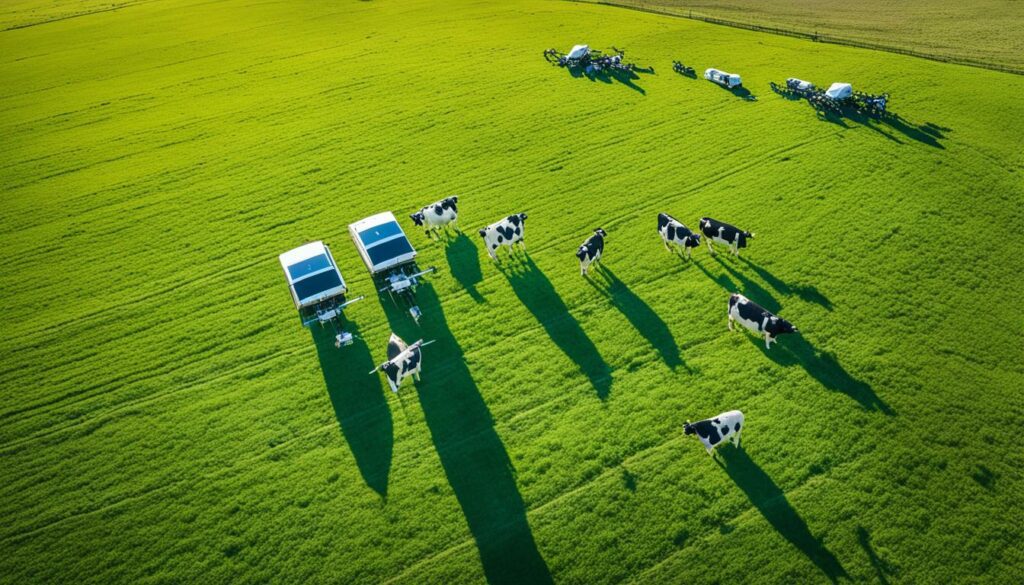
AI and machine learning offer great insights for farming decisions. They are used to feed animals with exactly what they need. This makes herds healthier and uses resources better. It also helps in reducing waste, which is good for the environment.
Farming, especially livestock farming, is a big source of greenhouse gases. Cattle and dairy cows produce a lot of these gases. These make a bigger impact than most countries. So, using tech to monitor and care for animals can help reduce these harmful effects.
Modernising farming through automation and digital tools reduces work and mistakes. It makes everything more efficient. This saves money and pleases consumers who want ethical, sustainable products. Livestock technologies are part of meeting this demand.
Good feeding management is key for sustainable farming. It affects how resources are used and the impact on the environment. With new technology, we can now feed animals exactly what they need. This is known as precision feeding. It helps keep animals healthy and is good for the planet by cutting down on waste and saving resources.
Precision feeding matches each animal’s diet to their nutritional needs. Farmers use IoT sensors and AI to keep track of what their animals eat and adjust as needed. The goal is to give each animal just the right nutrients, which cuts down on wasted food and makes feeding more efficient. This is a major part of making livestock farming sustainable, increasing productivity while caring for the environment.
Precision feeding isn’t just better for the animals; it saves a lot of resources too. Since precise amounts of feed are given, less is used overall. This means the farm’s impact on the environment is smaller. Also, by using less feed, farmers don’t need to buy as much, saving them money and saving natural resources.
Take a look at these facts to see how precision feeding helps:
| Metric | Traditional Feeding | Precision Feeding |
|---|---|---|
| Feed Waste Reduction | 10% | 25% |
| Improvement in Feed Efficiency | 30% | 45% |
| Overall Resource Savings | 20% | 35% |
Moving to precision feeding shows we’re heading in the right direction for sustainable farming. It focuses on doing things better and more effectively. This way, we can get better, safer food from animals, help the environment, and support farming that can last a long time.
Sustainable breeding management in the livestock sector plays a key role in reducing methane emissions. Ruminants, like cattle and sheep, are major methane producers. They release this gas as they digest their food (enteric fermentation). By managing how these animals breed, we can make a big difference in the amount of methane they create.

Looking at methane reduction strategies, we should focus on genetics. 20% of the methane a cow or sheep makes is from its genes. This means choosing animals to breed who are less likely to produce a lot of methane can help the planet.
Advanced technology like data analytics and genomics helps us pick the best animals for breeding. With these tools, farmers can select animals that produce less methane. This reduces harmful gas emissions and makes the farm more sustainable.
Digitalising and automating breeding management makes things smoother and more efficient. Using devices like IoT sensors and AI makes it easier to select and watch over animals. This leads to better methods to lower methane emissions over time.
Livestock farms should also move with what consumers want, which is often sustainability. Using responsible breeding to show a commitment to reducing methane is important. It helps build trust with consumers and secures the farm’s future in the market.
Keeping an eye on livestock behaviour is critical for modern farming. It offers real-time data on the animals’ well-being and health. With tools like IoT sensors and AI, farmers can watch individual animals closely. This helps them find any signs of sickness early on.
This keen observation helps make sure animals are well-cared for. It’s something many people care about when they buy food. Studies show that foods from happy animals are seen as better and safer. This means watching how animals behave is not only the right thing to do but also good for business.
The farming of animals also affects the environment, creating a big share of greenhouse gases. By using tech to watch over animals, the farming industry can lower these harmful effects. This method boosts the health and efficiency of the whole group.
Livestock farming contributes a lot to the planet’s greenhouse gas emissions. Yet, looking after animals through smart monitoring helps with environmental goals. It saves money, cuts down on harm to the planet, and boosts productivity. This way, it’s good for the animals and the pocket.
| Impact Area | Benefit |
|---|---|
| Animal Welfare | Proactive health management, improved living conditions |
| Sustainability | Efficient resource use, reduced GHG emissions |
| Consumer Perception | Healthier, safer, and tastier products |
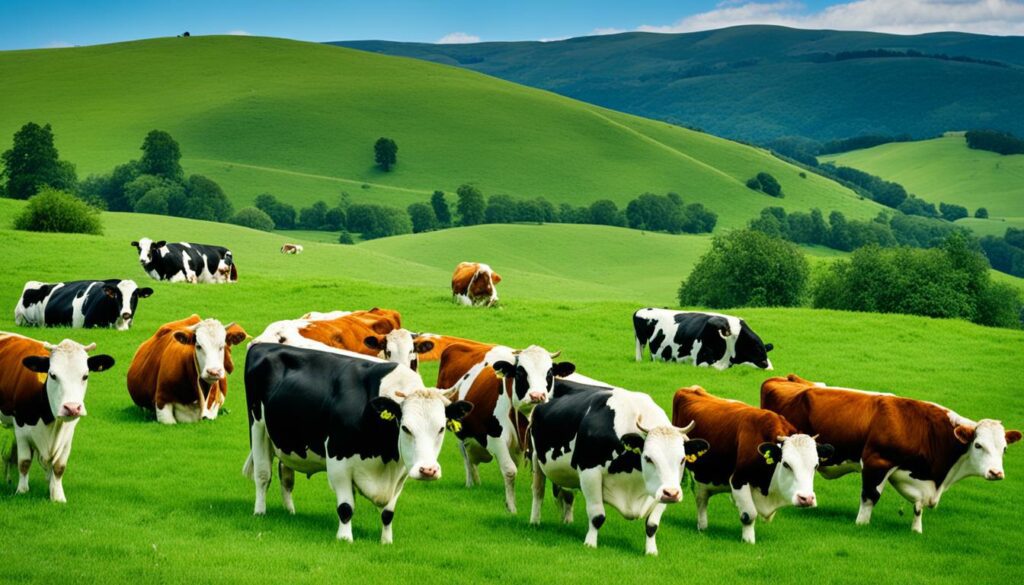
Choosing pasture-raised livestock supports better meat production. It offers animals healthier living conditions. As a result, the meat has higher nutritional value. For example, grassfed meat can have more CLA, which is good for health, than grainfed meat.
Yet, there are challenges with pasture-raised livestock. Effective land management is key. With fewer U.S. slaughterhouses for these animals now than in 1968, there are issues to overcome. Besides, the price for beef and chicken from pastured animals is higher. This difference shows the extra resources needed for this kind of farming.
There are many good reasons to like pasture-raised products. Eggs from these farms are lower in fat but higher in nutrients like Vitamin A and omega-3s. They’re much better for you than regular eggs. Also, meat from free-range chickens is leaner and less calorie-dense than that from factory farms.
It’s vital to carefully plan how we raise these animals. Farmers must ensure the right grasses and legumes are available. This way, the animals get the nutrition they need. By managing the feed this way, the meat becomes healthier for us to eat.
Achieving balance with pasture-raised livestock needs hard work and smart choices. Even with difficulties, the health and environmental advantages are clear. These systems support our aim for sustainable meat.
| Item | Pasture-Raised | Industrial |
|---|---|---|
| Cost of Beef | 33% higher | Standard |
| Cost of Chicken | 4 times higher | Standard |
| Fat in Eggs | 10% less | Standard |
| Vitamin A in Eggs | 40% more | Standard |
| Omega-3 in Eggs | 400% more | Standard |
Combining regenerative farming and livestock is key for making food in a sustainable way. It involves both animal grazing and growing crops. This practice is very helpful for keeping the soil healthy, capturing carbon, and making farms more sustainable.
Livestock in crop fields naturally improves the soil. They eat the grass and their manure adds nutrients. This helps with microbe activity and the cycle of nutrients in the soil. The result is soil that is more alive and fertile.
Cover crops are vital in regenerative farming. They stop the soil from washing away, make water soak in better, and add to the soil’s health. Adding livestock to these fields means their waste goes right into the soil. This makes it even better for farming. It also supports more insects, microbes, and fungi, which help plant growth.
| Practice | Benefit |
|---|---|
| Livestock Grazing | Reduces greenhouse gas emissions, enhances soil organic matter |
| Cover Crops | Reduces erosion, improves water infiltration and builds organic matter |
| Mixed Farming | Boosts soil health and supports agricultural ecosystems |
| Integrated Crop-Livestock Systems | Produces nutritious food and supports local communities |
Practising these methods helps farmers do well both economically and environmentally. It makes sure farming can continue for a long time. This way, we keep having food and a healthy planet.
The push for carbon-neutral animal farming is growing fast. New ways to tackle methane emissions are becoming economic bonuses too. Using better feed and breeding methods, the farming sector is making big green steps.
In carbon-neutral animal farming, a key step is to cut down on methane. Farm animals can be given supplements that reduce methane. Also, picking animals that naturally produce less methane helps. Countries like Colombia have seen good results using these methods. They increased milk production by 17% and cut production costs by 18.5%. This also helps the environment a lot.
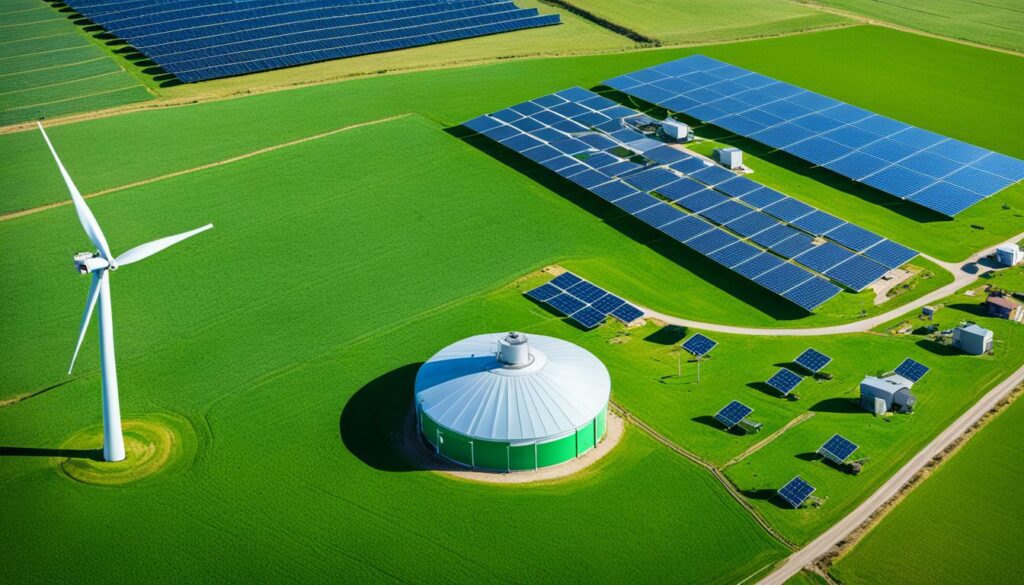
Thanks to new markets, farmers can now earn from cutting methane. These markets let them earn credits for reducing emissions. This makes going green profitable. The World Bank has put over 60% of its livestock funding towards these goals. It shows how you can make money and help the planet.
Around the world, there are big wins with green farming. Mexico, for example, cut 3 million tons of CO2 in 2016 with clean energy. If the livestock sector worldwide uses these methods, they can lower emissions by 14.5%. This helps keep food and nutrition secure for 1.3 billion people.
In the field of sustainable livestock production, maintaining high animal welfare standards is key. It involves ensuring animals live in the best conditions and get the healthcare and food they need. More people want products that meet these values because they view them as better and cleaner.
A Greener World (AGW) and similar organisations have important rules for farmers. The Certified Animal Welfare Approved standards by AGW are tough but good for the environment. They focus on the whole life of every farmed animal and encourage ways of farming that are good for the planet.
Farm animals play a big role in creating 14.5% of the world’s greenhouse gases. To help, farming needs to focus on welfare to cut these emissions. This can be done by picking the right animals to breed and by managing them better.
It was found that about one-fifth of a cow’s burp, which is a major source of methane, comes from its genes. This means we can lower the bad effects of farming on the planet by choosing the right animals to breed. Doing this also improves how animals are treated.
AGW updates its rules each year to match the latest research. This is important. It means that as we learn more, the ways we care for animals get better.
AGW’s certifications help shoppers who care about animal welfare feel more confident. Almost 90% of those who buy organic food think these welfare standards should be high.
So, making sure animals are treated well isn’t just about being nice. It’s a big part of making farming sustainable. As people look for food that’s kind to animals and the Earth, the agriculture sector needs to keep up. This is how we meet the needs of both shoppers and the planet.
As a livestock farmer, I’ve seen a big change in what consumers want. They’re now more interested in knowing where their food comes from. People want their food to be good for the Earth and the animals it comes from.
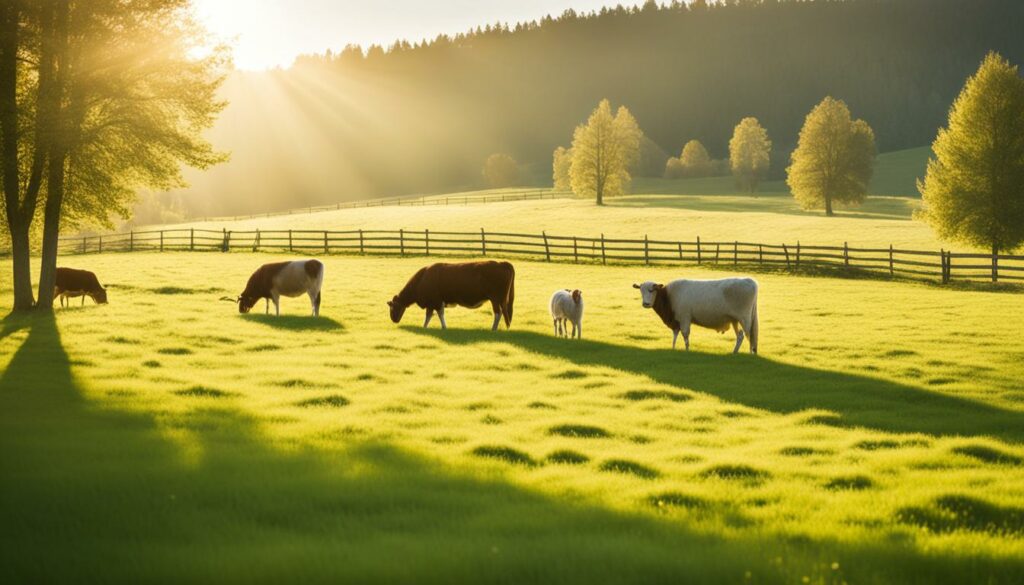
Being ethical in farming means caring about the planet and the animals. The American Grassfed Association (AGA) works to make sure animals are treated right. They say animals must eat grass, be outside, and not kept in small spaces. This is the kind of farming that many shoppers support.
Farm animals might produce a lot of harmful gases. So, being green is more important than ever. Farmers can help by using methods that lower these gases. This is what more and more customers want to see.
Responding to what people want means making food that is good for you and safe. By not using some stuff like antibiotics and added hormones, foods become healthier. This makes shoppers who care about their health happy. It also makes our food better for everyone.
| Aspect | Ethical Practices | Consumer Benefits |
|---|---|---|
| Animal Diet | 100% grass-fed | Healthier meat products |
| Animal Treatment | Humane and on-pasture raising | Better animal welfare, improved taste |
| Antibiotics & Hormones | Prohibited | Safer, chemical-free products |
| Sustainability | Regenerative farming techniques | Reduced environmental impact |
Farmers can change how they work to match what people expect. Keeping good records and always improving helps a lot. This way, farmers make food in a way that makes everyone happy. It keeps the farm doing well and helps the local area, too.
The need for sustainable livestock farming is very important now. The meat industry causes 7.1 gigatons of CO2 each year. This is 14.5% of all human-caused greenhouse gases. It’s key to use sustainable methods to lessen this harm. Things like digitalising and automating how we manage livestock show promise. They can help cut emissions, make processes better, and ensure the public trusts the industry more.
Animals like cows release a lot of methane, which is bad for the environment. With smart breeding and choosing the right genetics, we can cut emissions in cattle farming by about 20%. Adding digital tools and using data can also make things better for the animals. It improves efficiency and makes the food we get healthier. It means better business for farmers, too.
Livestock farming is the top source of climate-warming gases from farming. By using new technologies and green ways, farmers can do better. This leads to using resources more wisely, caring for animals more, and meeting what people want today. Through these efforts, we can make sure that farming in a way that protects our planet and still makes money is the norm. This is essential for the Earth’s future.
Sustainable livestock farming uses eco-friendly methods to produce food. It aims to reduce harm to the environment, improve food safety, and raise animal welfare. It considers economic factors alongside animal health and cutting down on CO2 emissions.
The livestock sector is responsible for 14.5% of global greenhouse gas emissions. This is due mostly to CO2 equivalent emissions. Sustainable farming looks to lower these emissions by using greener methods, making food safer, and treating animals better.
Good soil health is key for sustainable farming. Using regenerative methods helps soil stay healthy. Things like cover crops stop erosion, help water soak in, build up the soil, and add to biodiversity. Adding animals to these methods helps improve the soil naturally.
New tech, like digitalisation and smart tools, are very helpful. They include sensors, AI, and automated systems. This tech makes managing herds easier, lowers manual work, and saves money. It keeps an eye on animals’ wellness, helping with food, growth, and health management.
Precision feeding is using technology to feed each animal perfectly. It means giving the exact amount of feed needed, cutting waste, and using resources well. This kind of feeding saves resources and keeps the animals healthier.
For less methane, breeding can make a big difference. By picking the right genes with info on eating and genetics, farmers can choose animals that produce less gas. This lowers the herd’s effect on the planet.
Watching animal behaviour is key to maintaining their welfare. High-tech tools spot unusual behaviour that might mean an animal is sick. Dealing with problems early on keeps the animals happier and their food better.
Livestock raised on grass are good in many ways but also have some issues. They’re better for the animals and the earth. Yet, making sure there’s enough to eat and space for them can be hard. Keeping a good balance is vital for the ecosystem and the animals’ health.
When we add animals to regenerative farming, it improves the soil. They help by spreading manure and eating stuff, which makes the land healthier. This boosts the environment and helps things grow better.
To be carbon-neutral, farming methods focus on reducing methane. By using special feeds and breeding choices, farmers can cut down on emissions. They might get money for this by joining special markets. This helps to reduce overall emissions.
Looking after animals well is a must for sustainable farming. It leads to better food and meets what customers want. This means people are more likely to buy food from farms that treat their animals well.
To meet what customers want, farmers are using ethical methods. This helps make food healthier, tastier, and safer. It also follows what people think is important, changing the market and what people choose to buy.